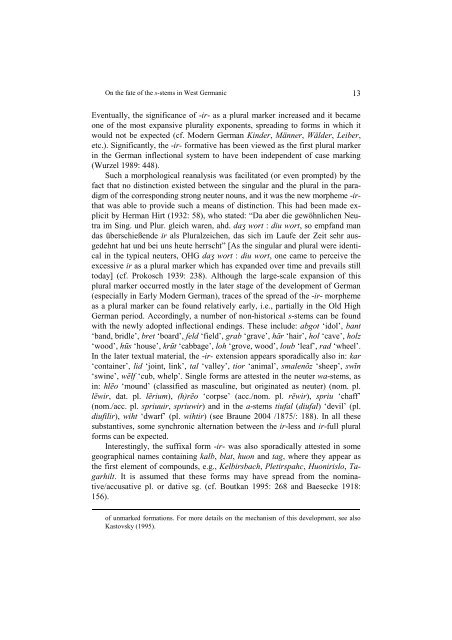s - Wyższa SzkoÅa Filologiczna we WrocÅawiu
s - Wyższa SzkoÅa Filologiczna we WrocÅawiu
s - Wyższa SzkoÅa Filologiczna we WrocÅawiu
You also want an ePaper? Increase the reach of your titles
YUMPU automatically turns print PDFs into web optimized ePapers that Google loves.
On the fate of the s-stems in West Germanic 13<br />
Eventually, the significance of -ir- as a plural marker increased and it became<br />
one of the most expansive plurality exponents, spreading to forms in which it<br />
would not be expected (cf. Modern German Kinder, Männer, Wälder, Leiber,<br />
etc.). Significantly, the -ir- formative has been vie<strong>we</strong>d as the first plural marker<br />
in the German inflectional system to have been independent of case marking<br />
(Wurzel 1989: 448).<br />
Such a morphological reanalysis was facilitated (or even prompted) by the<br />
fact that no distinction existed bet<strong>we</strong>en the singular and the plural in the paradigm<br />
of the corresponding strong neuter nouns, and it was the new morpheme -irthat<br />
was able to provide such a means of distinction. This had been made explicit<br />
by Herman Hirt (1932: 58), who stated: “Da aber die gewöhnlichen Neutra<br />
im Sing. und Plur. gleich waren, ahd. daʒ wort : diu wort, so empfand man<br />
das überschießende ir als Pluralzeichen, das sich im Laufe der Zeit sehr ausgedehnt<br />
hat und bei uns heute herrscht” [As the singular and plural <strong>we</strong>re identical<br />
in the typical neuters, OHG daʒ wort : diu wort, one came to perceive the<br />
excessive ir as a plural marker which has expanded over time and prevails still<br />
today] (cf. Prokosch 1939: 238). Although the large-scale expansion of this<br />
plural marker occurred mostly in the later stage of the development of German<br />
(especially in Early Modern German), traces of the spread of the -ir- morpheme<br />
as a plural marker can be found relatively early, i.e., partially in the Old High<br />
German period. Accordingly, a number of non-historical s-stems can be found<br />
with the newly adopted inflectional endings. These include: abgot ‘idol’, bant<br />
‘band, bridle’, bret ‘board’, feld ‘field’, grab ‘grave’, hār ‘hair’, hol ‘cave’, holz<br />
‘wood’, hūs ‘house’, krūt ‘cabbage’, loh ‘grove, wood’, loub ‘leaf’, rad ‘wheel’.<br />
In the later textual material, the -ir- extension appears sporadically also in: kar<br />
‘container’, lid ‘joint, link’, tal ‘valley’, tior ‘animal’, smalenōz ‘sheep’, swīn<br />
‘swine’, wēlf ‘cub, whelp’. Single forms are attested in the neuter wa-stems, as<br />
in: hlēo ‘mound’ (classified as masculine, but originated as neuter) (nom. pl.<br />
lēwir, dat. pl. lērium), (h)rēo ‘corpse’ (acc./nom. pl. rēwir), spriu ‘chaff’<br />
(nom./acc. pl. spriuuir, spriuwir) and in the a-stems tiufal (diufal) ‘devil’ (pl.<br />
diufilir), wiht ‘dwarf’ (pl. wihtir) (see Braune 2004 /1875/: 188). In all these<br />
substantives, some synchronic alternation bet<strong>we</strong>en the ir-less and ir-full plural<br />
forms can be expected.<br />
Interestingly, the suffixal form -ir- was also sporadically attested in some<br />
geographical names containing kalb, blat, huon and tag, where they appear as<br />
the first element of compounds, e.g., Kelbirsbach, Pletirspahc, Huonirislo, Tagarhilt.<br />
It is assumed that these forms may have spread from the nominative/accusative<br />
pl. or dative sg. (cf. Boutkan 1995: 268 and Baesecke 1918:<br />
156).<br />
of unmarked formations. For more details on the mechanism of this development, see also<br />
Kastovsky (1995).
















